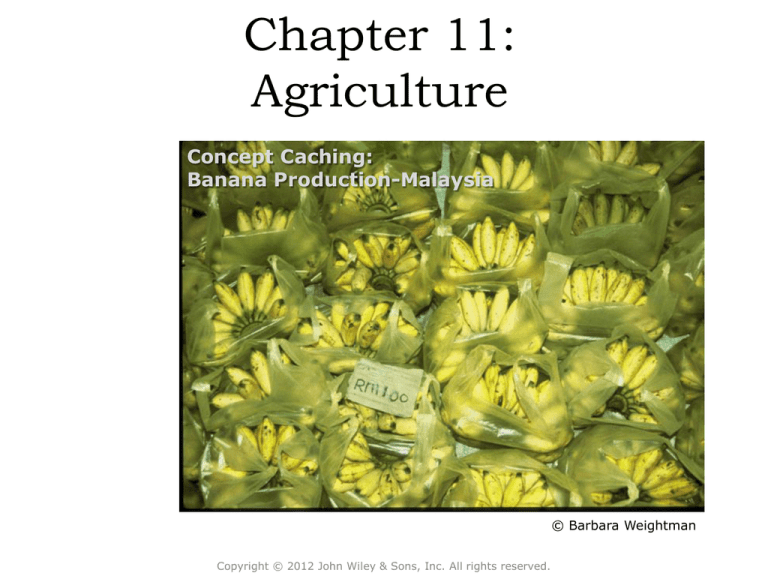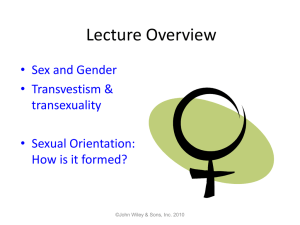
Chapter 11:
Agriculture
Concept Caching:
Banana Production-Malaysia
© Barbara Weightman
Copyright © 2012 John Wiley & Sons, Inc. All rights reserved.
Field Note:
Changing Greens
“Driving across the semiarid ranchlands of western South Dakota, I noticed the
presence of a crop in the landscape that was recently found only in the eastern,
moister region of the state: soybeans. I called a colleague who works in agriculture at
South Dakota State University to ask, “When did the cattle ranchers of western South
Dakota start growing soybeans?” He replied, “When the soy biodiesel plants started
popping up in Nebraska and Kansas and when genetically modified soybeans made it
possible to grow the
crop here.”
© 2012 John Wiley & Sons, Inc. All rights reserved.
Key Question
What is agriculture, and where
did agriculture begin?
© 2012 John Wiley & Sons, Inc. All rights reserved.
• Agriculture is the deliberate tending of crops and
livestock to produce food, feed, fiber, and fuel.
• Primary economic activities: Economic activities
that involve the extraction of economically valuable
products from the earth, including agriculture,
ranching, hunting and gathering, fishing, forestry,
mining, and quarrying.
• Secondary economic activities: Activities (e.g.,
manufacturing) that take a primary product and
change it into something else such as toys, ships,
processed foods, chemicals, and buildings.
• Tertiary economic activities are those service
industries that connect producers to consumers
and facilitate commerce and trade or help people
meet their needs.
© 2012 John Wiley & Sons, Inc. All rights reserved.
• Some analysts separate specialized services into
quaternary and quinary economic activities,
distinguishing between those services concerned
with information or the exchange of money or
goods (quaternary) and those tied to research or
higher education (quinary).
• In the United States, less than 2 percent of the
workforce is involved in agricultural production.
• In the United States, total agricultural production
is at an all-time high, but the proportion of the
labor force in agriculture is at an all-time low.
• The drive toward economic efficiency has meant
that the average size of farms (acres in production)
in the United States has been growing, regardless
of the kind of agricultural good produced.
© 2012 John Wiley & Sons, Inc. All rights reserved.
What Is Agriculture, and
Where Did Agriculture Begin?
• National Research Council of the U.S. National
Academy of Sciences identifies four major issues
that affect food security worldwide:
1. Varying abilities to balance production and
consumption across regions and countries
2. Accelerating conversions of agricultural land to
urban uses
3. Increasingly energy-intensive food production
methods in a world of shrinking fossil fuel
resources
4. Expanding use of food crops for biofuel
production
© 2012 John Wiley & Sons, Inc. All rights reserved.
What Is Agriculture, and
Where Did Agriculture Begin?
Concept Caching:
Fenway Park, Boston, MA
Hunting, Gathering, and Fishing
• Before the advent of agriculture, hunting,
gathering, and fishing were the most common
means of subsistence throughout the world.
• The size of hunting and gathering clans varied
according to climate and resource availability.
• Hunting and gathering communities in areas
of abundance could support larger
populations.
© 2012 John Wiley & Sons, Inc. All rights reserved.
Terrain and Tools
• The first tools used in hunting were simple clubs—
tree limbs that were thin at one end and thick and
heavy at the other.
• The use of bone and stone and the development of
spears made hunting far more effective.
• The first opportunities to control fire were offered by
natural conditions.
• In addition to hunting game on land, humans
harvested shellfish, trapped fish by cutting small
patches of standing water off from the open sea, and
invented tools to catch fish, including harpoons,
hooks, and baskets.
• Using tools and fire, human communities altered
their environments, which helped to establish more
reliable food supplies.
© 2012 John Wiley & Sons, Inc. All rights reserved.
The First Agricultural Revolution
• Geographer Carl Sauer: the experiments
necessary to establish agriculture and settle
in one place would occur in lands of plenty.
• Sauer suggested that Southeast and South
Asia may have been where the first tropical
plant domestication occurred, more than
14,000 years ago.
• Root crops: crops that are reproduced by
cultivating either the roots or cuttings from
the plants.
© 2012 John Wiley & Sons, Inc. All rights reserved.
What Is Agriculture, and
Where Did Agriculture Begin?
The First Agricultural Revolution
• Seed crops: plants that are reproduced by
cultivating seeds.
• The cultivation of seed crops marked the
beginning of what has been called the First
Agricultural Revolution.
• The majority view is that the first
domestication of seed plants took place in
the Fertile Crescent.
© 2012 John Wiley & Sons, Inc. All rights reserved.
© 2012 John Wiley & Sons, Inc. All rights reserved.
Domestication of Animals
• Some scholars believe that animal domestication
began earlier than plant cultivation, but others
argue that animal domestication began as recently
as 8000 years ago—well after crop agriculture.
• The advantages of animal domestication—their use
as beasts of burden, as a source of meat, and as
providers of milk—stimulated the rapid diffusion of
this idea among interlinked places and gave the
sedentary farmers of Southwest Asia and elsewhere
a new measure of security.
• Jared Diamond, Guns, Germs, and Steel: only five
domesticated mammals are important throughout
the world: the cow, sheep, goat, pig, and horse.
© 2012 John Wiley & Sons, Inc. All rights reserved.
Field Note
“Attempts to tame wildlife started in ancient times, and still continue. At
Hunter’s Lodge on the Nairobi-Mombasa road, we met an agricultural officer who
reported that an animal domestication experiment station was located not far
into the bush, about 10 miles south. On his invitation, we spent the next day
observing this work. In some herds, domestic animals (goats) were combined
with wild gazelles, all penned together in a large enclosure. This was not working
well; all day the gazelles seek to escape. By comparison, these eland were docile,
manageable, and in good health. Importantly, they also were reproducing in
captivity. Here, our host describes the program.”
© 2012 John Wiley & Sons, Inc. All rights reserved.
Subsistence Agriculture
• Subsistence agriculture: growing only enough food to
survive; norm throughout most of human history.
• Subsistence agriculture is returning in parts of the world
where farmers feel production for the global market has
not benefited them financially or culturally.
• Shifting cultivation: many farmers move from place to
place in search of better land.
– Found primarily in tropical and subtropical zones,
where traditional farmers had to abandon plots of
land after the soil became infertile.
– Slash-and-burn agriculture: farmers use tools
(machetes and knives) to slash down trees and tall
vegetation, and then burn the vegetation on the
ground. A layer of ash from the fire settles on the
ground and contributes to the soil’s fertility.
© 2012 John Wiley & Sons, Inc. All rights reserved.
Settling down in one place, a rising
population, and the switch to agriculture are
interrelated occurrences in human history.
Hypothesize which of these three happened
first, second, and third and explain why.
© 2012 John Wiley & Sons, Inc. All rights reserved.
Key Question
How did agriculture change with
industrialization?
© 2012 John Wiley & Sons, Inc. All rights reserved.
Second Agricultural Revolution
• Would move agriculture beyond subsistence to
generate the kinds of surpluses needed to feed
thousands of people working in factories instead of in
agricultural fields.
• Great Britain’s Enclosure Act: encouraged field
consolidation into large, single-owner holdings.
• New technologies (i.e., the seed drill).
• Mechanical reaper perfected in 1831 by farmer Cyrus
McCormick.
• Advances in breeding livestock.
• Innovations in machinery that occurred with the
Industrial Revolution in the late 1800s and early
1900s helped sustain the Second Agricultural
Revolution.
© 2012 John Wiley & Sons, Inc. All rights
reserved.
© 2012 John Wiley & Sons, Inc. All rights reserved.
Understanding the Spatial Layout of
Agriculture
• Farmer Johann Heinrich von Thünen: As one
moved away from the town one commodity or crop
gave way to another.
• The greater the distance to market, the higher the
transport costs that had to be added to the cost of
producing a crop or commodity.
• The Von Thünen model (including the ring of
forest) is often described as the first effort to
analyze the spatial character of economic activity.
• Even when agricultural production does not
conform to the concentric rings of von Thünen’s
model, his underlying concern with the interplay of
land use and transportation costs frequently still
explains agricultural patterns.
© 2012 John Wiley & Sons, Inc. All rights reserved.
Figure 11.7
Von Thünen’s Model.
© H. J. de Blij, P. O. Muller,
and John Wiley & Sons, Inc.
© 2012 John Wiley & Sons, Inc. All rights reserved.
The Third Agricultural Revolution
• Also called the Green Revolution.
• Dates as far back as the 1930s, when agricultural
scientists in the American Midwest began
experimenting with technologically manipulated
seed varieties to increase crop yields.
• 1960s: the focal point of the Green Revolution
shifted to India (IR8).
• 1982: IR36 was produced, bred from 13 parents to
achieve genetic resistance against 15 pests and a
growing cycle of 110 days under warm conditions.
• The Green Revolution also brought new high-yield
varieties of wheat and corn from the United States
to other parts of the world, particularly South and
Southeast Asia.
© 2012 John Wiley & Sons, Inc. All rights reserved.
Criticism of the Green Revolution
• Environmentalists have speculated about the impacts of
pollen dispersal from genetically modified plants and the
potential for disease-resistant plants to spur the evolution of
super-pests.
• The large-scale monocropping that is often part of Green
Revolution agriculture can make farms vulnerable to
changes in climate or the infestation of particular pests.
• Higher inputs of chemical fertilizers, herbicides, and
pesticides associated with Green Revolution agriculture can
lead to reduced organic matter in the soil and to
groundwater pollution.
• Scientific American (2005) explains that the Green
Revolution has done little to alleviate poverty in areas where
most farmers still work small plots of land.
• The need for capital from the West to implement Green
Revolution technologies has led to a shift away from
production for local consumers toward export agriculture.
© 2012 John Wiley & Sons, Inc. All rights reserved.
New Genetically Modified Foods
• Genetically modified organisms (GMOs) are found in 75
percent of all processed foods in the United States
• Many of the poorer countries of the world do not have access
to the necessary capital and technology.
• Ideological resistance to genetically engineered foods
• In regions where seeds are a cultural commodity, reflecting
agricultural lessons learned over generations, many resist the
invasion of foreign, genetically engineered crops.
Concept Caching:
Planting Rice
Seedlings-China
© Barbara Weightman
© 2012 John Wiley & Sons, Inc. All rights reserved.
Regional and Local Change
• Shifts from subsistence agriculture to
commercial agriculture have had dramatic
impacts on rural life.
• Dramatic increases in the production of
export crops have occurred at the expense of
crop production for local consumption.
• Environmental, economic, and social changes
have affected local rural communities.
© 2012 John Wiley & Sons, Inc. All rights reserved.
Guest Field Note:
Gambia
“I am interested in women and
rural development in Subsaharan
Africa. In 1983, I went to Gambia
to study an irrigated rice project
that was being implemented to
improve the availability of rice, the
dietary staple. What grabbed my
attention? The donors’ assurance
that the project would benefit
women, the country’s traditional
rice growers. Imagine my surprise
a few months after project
implementation when I
encountered hundreds of angry
women refusing to work because
they received nothing for their
labor from the first harvest.”
© 2012 John Wiley & Sons, Inc. All rights reserved.
The Impacts of Agricultural
Modernization on Earlier Practices
• Unlike hunting and gathering, subsistence farming
continues to be a relatively common practice in Africa,
Middle America, tropical South America, and parts of
Southeast Asia.
• From 1500 to 1950, European powers sought to
Concept Caching:
“modernize” the
economies of their colonies by ending
Mount Vesuvius
subsistence farming and integrating farmers into
colonial systems of production and exchange.
• The colonial powers would demand that farmers pay
some taxes.
• The colonial powers would conduct soil surveys, build
irrigation systems, and establish lending agencies that
provided loans to farmers.
© 2012 John Wiley & Sons, Inc. All rights reserved.
Many arguments have been raised about the
impacts of the Green Revolution, both pro and
con. How might the scale at which the Green
Revolution is examined affect the arguments
that are made about it? What types of factors
are likely to be considered if the question is,
“has the Green Revolution been good for Asia”
as opposed to “has the Green Revolution been
good for a village or a particular agricultural
community in India?”
© 2012 John Wiley & Sons, Inc. All rights reserved.
Key Question
What imprint does agriculture
make on the cultural
landscape?
© 2012 John Wiley & Sons, Inc. All rights reserved.
• The cadastral system: the method of land survey through
which land ownership and property lines are defined.
• Rectangular survey system: The prevailing survey
system throughout much of the United States, the one
that appears as checkerboards across agricultural fields
• The pattern of farms on the landscape in the interior of
the United States reflects the township-and-range
system, with farms spaced by sections, half sections, or
quarter sections.
• Metes and bounds survey: natural features were used
to demarcate irregular parcels of land.
• Long-lot survey system: divided land into narrow
parcels stretching back from rivers, roads, or canals.
• Primogeniture: the Germanic practice in which all land
passes to the eldest son.
• In areas where land is divided among heirs, considerable
fragmentation can occur over time.
© 2012 John Wiley & Sons, Inc. All rights reserved.
Figure 11.10
Willamette Valley, Oregon. The township-and-range system has left its
imprint on the landscape near Eugene, Oregon, where the grid pattern of
six mile by six mile townships and the sections of one square mile each
are marked by property lines and roads. © Alexander B. Murphy.
© 2012 John Wiley & Sons, Inc. All rights reserved.
© 2012 John Wiley & Sons, Inc. All rights reserved.
Villages
• True farm villages, in which farming or providing services for
farmers are the dominant activities, are disappearing
• Dispersed settlement pattern: individual farmhouses lie quite
far apart and the land is intensively cultivated but by machine
rather than by hand Ex: United States Midwest
• Nucleated settlement: the most prevalent rural residential
pattern in agricultural areas
Figure 11.12
Acquitaine, France. The
agricultural landscape of Aquitaine
demonstrates three features of
rural France: people living in
nucleated villages, a highly
fragmented land ownership pattern,
and land divided according to the
French long-lot system.
© Alexander B. Murphy.
© 2012 John Wiley & Sons, Inc. All rights reserved.
Villages
• Linear village: In many low-lying areas of Western
Europe, villages are located on dikes and levees.
• Cluster village may have begun as a small hamlet
at the intersection of two roads and then developed
by accretion.
• Round village or rundling was first used by Slavic
farmer-herdsmen in eastern Europe and was later
modified by Germanic settlers.
• Walled village: as a means of protection.
• Grid village: more modern.
© 2012 John Wiley & Sons, Inc. All rights reserved.
© 2012 John Wiley & Sons, Inc. All rights reserved.
Functional Differentiation within
Villages
• Social stratification: reflected in the range
in size and quality of houses, representing
their owners’ wealth and standing in the
community.
• The functional differentiation of buildings
within farm villages is more elaborate in
some societies than in others.
• Protection of livestock and storage of
harvested crops are primary functions of
farm villages.
© 2012 John Wiley & Sons, Inc. All rights reserved.
Figure 11.14
Siem Reap, Cambodia. A stilt village in
the Mekong Basin of Cambodia. ©
Barbara A. Weightman
Figure 11.15
Winthrop, Minnesota. The modern
American farm typically has a two-story
farm house surrounded by several
outbuildings. © Erin H. Fouberg.
© 2012 John Wiley & Sons, Inc. All rights reserved.
Key Question
How is agriculture currently
organized geographically, and
how has agribusiness
influenced the contemporary
geography of agriculture?
© 2012 John Wiley & Sons, Inc. All rights reserved.
• The end of colonial rule did not signal the end
of the agricultural practices and systems that
had been imposed on the former colonial areas.
• Commercial farming has come to dominate in
the world’s economic core, as well as some of
the places in the semi-periphery and periphery.
• Commercial agriculture: began in the
eighteenth and nineteenth centuries when
Europe became a market for agricultural
products from around the world.
• Monoculture: dependence on a single
agricultural commodity; a major impact of
colonial agriculture.
© 2012 John Wiley & Sons, Inc. All rights reserved.
Field Note
“The technology of refrigeration has kept pace with the containerization
of seaborne freight traffic. When we sailed into the port of Dunedin,
New Zealand, I was unsure of just what those red boxes were. Closer
inspection revealed that they are refrigeration units, to which incoming
containers are attached. Meats and other perishables can thus be kept
frozen until they are transferred to a refrigerator ship.”
© 2012 John Wiley & Sons, Inc. All rights reserved.
The World Map of Climates
• Wladimir Köppen: Köppen climate classification
system for classifying the world’s climates on the
basis of temperature and precipitation.
• Köppen’s map provides one means of
understanding the distribution of climatic regions
(areas with similar climatic characteristics) across
the planet.
© 2012 John Wiley & Sons, Inc. All rights reserved.
The World Map of Climates
© 2012 John Wiley & Sons, Inc. All rights reserved.
The World Map of Climates
• The “no dry season” (Af) regions are equatorial
rainforest regions.
• The “short dry season” (Am) climate is known as
the monsoon climate.
• BW is desert and BS is steppe.
• “Dry summer” (C) climates are known as
Mediterranean climates.
• Polar climates, where tundra and ice prevail, are
found poleward of (D) climates.
© 2012 John Wiley & Sons, Inc. All rights reserved.
The World Map of Agriculture
INSERT FIGURE 11.18
© 2012 John Wiley & Sons, Inc. All rights reserved.
The World Map of Agriculture
Cash Crops and Plantation Agriculture
• Cash farming continues to provide badly needed
money, even if the conditions of sale to the urban
industrial world are unfavorable.
• Occasionally, producing countries consider forming
a cartel in order to present a united front to the
importing countries and to gain a better price, as
oil-producing states did during the 1970s.
• Plantation agriculture: When cash crops are
grown on large estates:
• Plantations are colonial legacies that persist in
poorer, primarily tropical, countries along with
subsistence farming.
© 2012 John Wiley & Sons, Inc. All rights reserved.
Commercial Livestock, Fruit,
and Grain Agriculture
• Commercial Livestock, Fruit, and Grain Agriculture
• Livestock ranching: the raising of domesticated
animals for the production of meat and
byproducts, such as leather and wool
• Subsistence agriculture
• Subsistence crop and livestock farming
• Intensively subsistence farming (chiefly rice)
• Intensively subsistence farming (chiefly wheat
and other crops
• Mediterranean Agriculture: specialized farming
occurs only in areas where the dry summer
Mediterranean climate prevails
© 2012 John Wiley & Sons, Inc. All rights reserved.
Drug Agriculture
• Because of the high demand for drugs—
particularly in the global economic core—farmers
in the periphery often find it more profitable to
cultivate poppy, coca, or marijuana plants than to
grow standard food crops.
• Drug cartels that oversee the drug trade have
brought crime and violence to the places where
they hold sway.
• Mexicans now control 11 of the 13 largest drug
markets in the United States.
© 2012 John Wiley & Sons, Inc. All rights reserved.
• Informal agriculture: Millions of people cultivate
small plots of land in and around their homes for
domestic consumption or to trade informally with
others.
• Such practices are encouraged in some places—
notably China—but more often they are ignored, or
even discouraged.
Concept Caching: Produce bazaar in
Ghazni City, Afghanistan
© Barbara Weightman
© 2012 John Wiley & Sons, Inc. All rights reserved.
Political Influences on Agriculture
• Cash crop: cotton
• Colonial powers established a trading network that
led to the globalization of the cotton industry.
• Cotton cultivation expanded greatly when the
Industrial Revolution produced machines for cotton
ginning, spinning, and weaving that increased
productive capacity, brought prices down, and put
cotton goods within the reach of mass markets.
• Even as countries emerged from colonial control, they
were left with a legacy of large landholdings owned or
controlled by wealthy individuals or business entities.
• Tax regulations and subsidies favoring certain land
uses.
© 2012 John Wiley & Sons, Inc. All rights reserved.
Socio-cultural Influences on
Agriculture
• Luxury crops, such as coffee:
• In most cases coffee is produced on enormous,
foreign-owned plantations, where it is picked by
local laborers who are hired at very low wage rates
• Fair trade: guarantees coffee producers a “fair
trade price” of $1.40 per pound of coffee (plus
bonuses of $0.30 per pound for organic)
• People’s changing tastes also shape the geography
of agriculture (e.g., tea)
© 2012 John Wiley & Sons, Inc. All rights reserved.
Agribusiness and the Changing
Geography of Agriculture
• Agribusiness: the businesses that provide a vast
array of goods and services to support the
agricultural industry.
• A global network of farm production is oriented to
the one-fifth of the world’s population that is highly
urbanized, wealthy, and powerful.
• Few farmers in distant lands have real control over
land-use decisions, for the better off people in the
global economic core continue to decide what will
be bought at what price.
© 2012 John Wiley & Sons, Inc. All rights reserved.
Environmental Impacts of
Commercial Agriculture
• Overfishing
• Land clearing and deforestation
• Concerns over the introduction of chemical
fertilizers and pesticides into the environment—as
well as soil erosion.
• Ecological degradation and desertification
• The growth of organic farming and the move
toward the use of local foods in some communities
can benefit the environment.
© 2012 John Wiley & Sons, Inc. All rights reserved.
The Challenge of Feeding Everyone
• Worldwide, about 1 billion people are malnourished.
• Inadequate distribution systems and widespread
poverty.
• Some of the most fertile, productive farmlands are
lost to housing and retail developments.
• Commercial agricultural areas are converted into
regions for second homes.
• Population growth and the loss of agricultural land
help to explain why global food prices have been on
the rise for more than a decade.
• Food deserts are areas with limited access to fresh,
nutritious foods.
© 2012 John Wiley & Sons, Inc. All rights reserved.
INSERT FIGURE 11.23
© 2012 John Wiley & Sons, Inc. All rights reserved.
Additional Resources
• Food production and development
http://www.foodfirst.org/media/opeds/2000/4greenrev.html
• Preservation of agricultural lands
http://www.farmland.org/
© 2012 John Wiley & Sons, Inc. All rights reserved.









